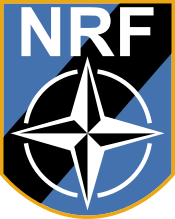NATO Response Force
| NATO Response Force | |
|---|---|
|
Emblem | |
| Active | 2003–present |
| Allegiance |
|
The NATO Response Force (NRF) is a high readiness force comprising land, air, sea, and special forces units capable of being deployed quickly on operations wherever needed.[1]
Background
The purpose of the NRF is to provide a quick reaction force of high quality to support NATO missions as required. The concept of NRF was first endorsed with a declaration of NATO's Heads of State at the Prague Summit on 22 November 2002. It was then approved by NATO Defence Ministers in June 2003, and the first headquarters created in October 2003 in Italy under command of NATO Joint Force Command in Brunssum, Netherlands, designated NRF 1. Its rotation replacement was designated NRF 2 (2004) at the same time.[2]
Rotating forces through the NRF requires nations to meet the demanding standards needed for collective defence and expeditionary operations. As the standards are very high, participation in the NRF is preceded by a six-month NATO exercise program in order to integrate and standardize the various national contingents. Generally, nations carry out a pre-training period in preparation for the NATO exercises of between 6-18 months. Once activated Reconnaissance Teams deploy within 5 days. This is the first of a number of deployment phases that lead to the deployment of the entire HQ Joint Task Force and Immediate Reaction Forces within 30 days.
Tasks
The NRF is certified by NATO to perform a wide variety of tasks including: providing an immediate response capability for conducting collective defence of Alliance members in the event of an Article V operation;
- crisis management operations;
- acting as the initial force deployment as a precursor to deployment of a much larger force;
- peace support operations;
- disaster relief;
- protection of critical infrastructure.
Structure
The NRF has three elements:
- Command and Control element;
- Immediate Response Force;
- Response forces Pool.
Command & Control element: This is based on a deployable Joint Force Headquarters. Supreme Allied Commander Europe (SACEUR) has overall strategic command of the NRF. NATO’s two Joint Force Commands, based in Brunssum, Netherlands and Naples, Italy take one-year turns to command the NRF.
Immediate Response Force (IRF): The IRF element is designed to provide the initial response to a crisis and is not scaled to be a stand-alone force for all but the smallest operations. If further land, maritime or air capabilities are required, they will be drawn from the Response Forces Pool.
Response Forces Pool (RFP): The RFP consists of a broad spectrum of military capabilities encompassing command and control, combat and support units. There is no fixed size to the RFP. The forces contributed to the RFP are drawn from the much wider pool of Allied or Partners National deployable forces.
Very High Readiness Joint Task Force (VJTF)
During the 2014 Wales summit NATO leaders agreed to establish a Very High Readiness Joint Task Force (VJTF). The VJTF will be a high-readiness "Spearhead Force" able to deploy at short notice to threats against NATO sovereignty. It will consist of a land brigade numbering around 5,000 troops, supported by air, sea and special forces. The VJTF would be supported by two more land brigades as a "rapid reinforcement capability" in case of a major crisis. Altogether, the enhanced NATO Response Force will amount to around 30,000 troops.[3]
Deployments
As of January 2015, units assigned to the NRF have been used on four occasions:
- Olympic Games in Athens in 2004;
- Afghan presidential elections in 2004;
- Humanitarian assistance following Hurricane Katrina in 2005;
- Humanitarian relief following the earthquake in Pakistan in 2006.
Non-NATO Participants
Of NATO's non-member partners, Finland and Sweden joined the Response Force in 2008[4] and 2013,[5] respectively. Ukraine and Georgia began its contribution, respectively, in 2014[6] and 2015.[7]
See also
- Combined Joint Expeditionary Force (CJEF)
- UK Joint Expeditionary Force
- Eurocorps
- Franco-German Brigade
Notes
- ↑ "NATO Response Force/Very High Readiness Joint Task Force: Fact Sheet". NATO. 9 March 2015. Retrieved 13 May 2015.
- ↑ Kugler, Richard (2007). "The NATO Response Force 2002–2006: Innovation by the Atlantic Alliance". Case Studies in Defense Transformation. Washington, DC: National Defense University, Center for Technology and National Security Policy: 8.
- ↑ "Defence Ministers agree to strengthen NATO's defences, establish Spearhead Force". nato.int (Press release). Brussels, BE: North Atlantic Treaty Organization. 2015-02-06 [First published 2015-02-05]. Archived from the original on 2015-02-06. Retrieved 2015-02-06.
- ↑ "Strategic Airlift Capability moves to implementation" (Press release). NATO. 1 October 2008. Retrieved 13 May 2015.
- ↑ "Sweden to join NATO Response Force and exercise Steadfast Jazz" (Press release). NATO. 14 October 2013. Retrieved 14 October 2013.
- ↑ "Developing constructive partnership between Ukraine and NATO". Ministry of Foreign Affairs of Ukraine. 2014. Retrieved 13 May 2015.
- ↑ "NATO Secretary General to Visit Georgia Next Week". Civil Georgia. Tbilisi, Georgia. 21 August 2015. Retrieved 21 August 2015.
External links
- Official Article on NATO Response Force
- critical NATO Review article
- Ukraine's MFA article
- NATO
- NRF Factsheet
- The NATO Response Force – Facilitating coalition warfare through technology transfer and information sharing
